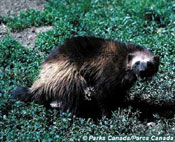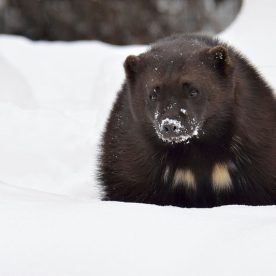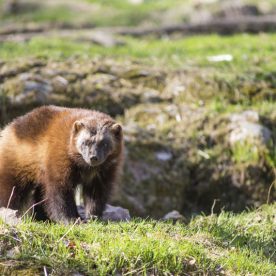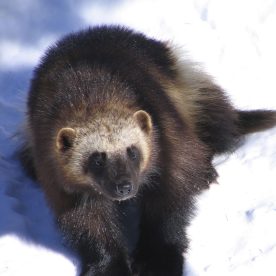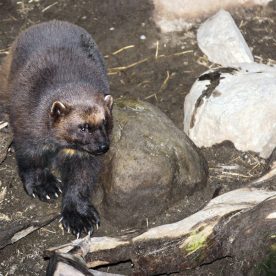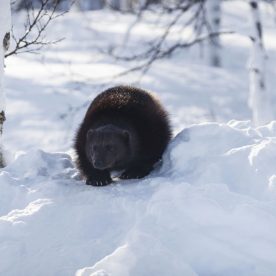Description
Although the Wolverine Gulo gulo belongs to the weasel family, Mustelidae, it is not as long and lean as typical weasels, but rather short and thick, like a small bear. Its head is broad and round, with small eyes and short rounded ears. Its legs are short and sturdy, with five toes on each foot. Its long, curved claws are semi-retractile, which means they can be partly drawn back in, and they are used for climbing and digging. Its teeth are strong, and its head, neck, and shoulder muscles are well-developed. These adaptations allow the Wolverine to feed on frozen flesh and bone, a survival tactic for the harsh and remote environments in which they reside.
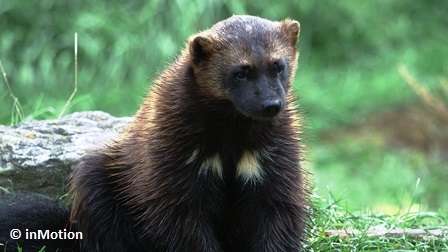
A Wolverine, with the pale markings on its chest
An adult Wolverine is about the size of a medium-sized dog. Adult males weigh about 12 to 18 kg, adult females about 8 to 12 kg. Wolverines that live in the north of their range are usually larger than those living farther south.
The Wolverine has one of the most striking furs among of all fur-bearing animals. Its fur is typically a rich, glossy, dark brown. Two pale stripes originate at the nape of its neck and sweep along each flank to merge at the base of its long, bushy tail. White or orange patches are common on the chest or throat. The Wolverine’s toes, forepaws, or legs may occasionally be marked with white.
Habitat and Habits
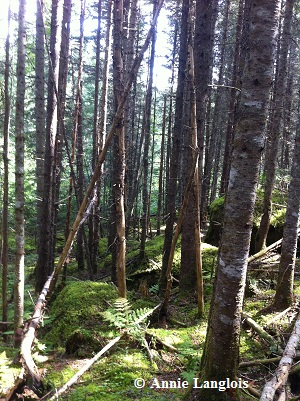
The boreal forest, one of the habitats used by the Wolverine
Within its range, the Wolverine occupies many different kinds of habitats. Wolverines are most likely to occur in remote areas, far away from humans and their developments. However, the reasons for their high sensitivity for human disturbance are still being studied, and are not yet known. Labrador and Québec, for example, don’t seem to have recolonized by Wolverines, despite the abundance of caribou and undisturbed habitat. This lack of knowledge about Wolverine habitat makes it difficult to manage the species and protect its habitat.
One specific type of habitat Wolverines need is the den used by females to give birth and raise their kits. Finding such a den is difficult. Most dens that have been found are in tundra and alpine regions and consist of a complex of snow tunnels associated with boulders or rocks. The configuration of the rocks results in natural cavities under the snow, which form dens for the Wolverines.
Studies are expensive and difficult to conduct because of Wolverines’ large home ranges and low densities. It is not surprising that we are still learning about the biology and behaviour of this species. Some of the mysteries have been dispelled with the help of studies in Alaska, Montana, British Columbia, Alberta, Yukon, Ontario, and Nunavut. In some studies, Wolverines are equipped with collars that allow their movements to be monitored using satellites. In others, Wolverines have been spotted with camera-traps, and their DNA is sampled with hair-traps.
The home range of an adult Wolverine extends from less than 100 km2 for females to over 1 500 km2 (a home range of more than 3 500 km2 has even been recorded) for males. These home ranges are the largest reported for a carnivore of this size, and in many areas they rival the home ranges of bears, wolves, and cougars. The size of the home range varies depending on the availability of food and how it is distributed across the landscape — the more food there is, the smaller the home range needs to be.
The density of Wolverines ranges from one individual per 40 km2 to one per 800 km2. Those regions that have the most different kinds of habitat and prey, particularly those that include large ungulates, or animals with hooves, tend to contain the highest densities of Wolverines. The mountainous and forested areas of British Columbia and Yukon serve as a stronghold for this species, although its numbers are still low compared with the densities of other carnivores. The rarity of Wolverines becomes readily apparent when their density is compared with the density of other solitary carnivores which may be as high as one Coyote per 0.5 to 10 km2 and one Grizzly Bear per 1.5 to 260 km2.
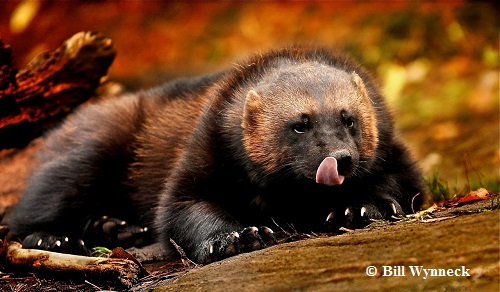
The Wolverine
Wolverines can travel long distances during their daily hunting activities with males travelling farther than females. One young male traversed 800 km in 8 days through Wyoming and Montana. They can use traditional routes, revisiting some of the same places every year. Wolverines are constantly on the move, unless they have found a kill site or are nursing young. The young leave their home range, or disperse, when they become sexually mature, at about one or two years of age. These dispersal movements can be extensive, 300 km and more for young males. The young females usually settle within or next to the area where they were born.
The Wolverine is known by a variety of descriptive names, including “skunk-bear,” because it marks its food and various landmarks with urine and musk, a fluid secreted from its anal glands, and “glutton,” because of its voracious appetite. The Wolverine species has been described as the fiercest creature on earth and a fearless aggressive fighter that will drive bears away from their kills. It is, in fact, the Wolverine’s reliance on scavenging in order to survive that has given rise to exaggerations about its gluttony and ferocity. However, this reputation is born from the legendary strength and tenacity of this animal as told by many northern trappers and hunters; there has never been a documented attack on a human by a Wolverine.
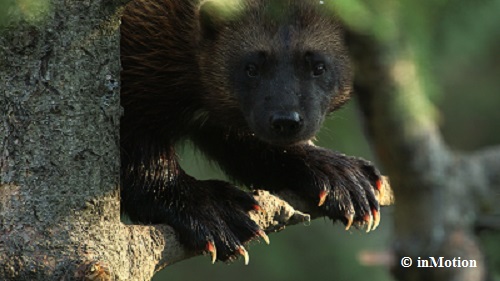
The Wolverine is a good climber due to its claws
The Wolverine is also a creature important in the folklore of North American First Nations peoples. However, because of its reputation and conflicts with trappers, the Wolverine was considered a pest by European North Americans, an attitude that persisted into the 1960s. Today, Wolverines’ numbers are greatly reduced in some areas, which is partly why very few people, even those who spend a lot of time outdoors, have seen Wolverines in the wild. This contributes to the animals’ mysterious reputation and explains why they are probably the most misunderstood and one of the least known of Canada’s wild animals.
Range
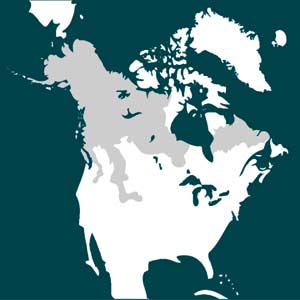
The Wolverine’s range in North America
The Wolverine is found throughout all northern regions of the globe. Still, Wolverines are not abundant anywhere, even where the conditions are most favourable. Historically, before the appearance of Europeans in North America, Wolverines occurred throughout Canada and Alaska, with some small extensions of this range into higher elevations in the western United States and into the Great Lakes and New England. They occupied a wide variety of habitat types, with the exception of dry, hot areas.
Over a third of the Wolverine’s historical range in North America has been lost. Wolverines have also disappeared from areas that are characterized by heavy human settlement, recreation and resource extraction activities. Eastern Canada and the western United States have been particularly hit hard: Wolverines disappeared most rapidly at the edges of their North American distribution. Wolverines are also thought to have disappeared from Vancouver Island. Similarly, we do not know if any Wolverines still occur in Labrador and Québec. No confirmation of the presence of the species in either Québec or Labrador has been recently reported. However, current investigation efforts are underway in Québec to attempt the detection of the species in areas where highly credible sighting have been reported in the last years. In Canada, the Committee on the Status of Endangered Wildlife in Canada considers Wolverines found west of Hudson Bay to be of “special concern” and the eastern population, found in Québec and Labrador, to be “endangered.”
Feeding
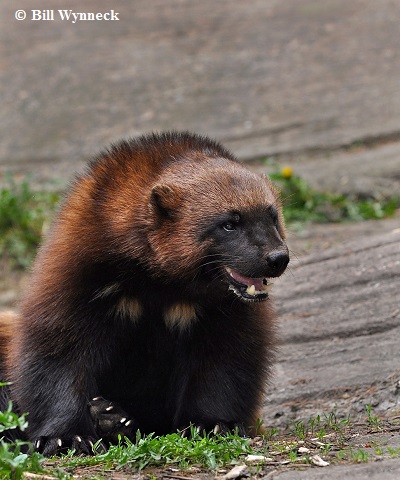
The Wolverine
The Wolverine is a carnivore, or flesh eater. It is more of a scavenger than a hunter, and is usually dependent on other carnivores, such as wolves, to kill the animals for it to eat. Leftovers from a wolf kill can be considerable. The Wolverine has been known to carry away moose carcasses and caribou heads. Because of its great dependence on carrion, or dead flesh, from large mammal kills, the Wolverine needs to be able to survive long periods without food. It will revisit old kills to consume frozen bones and pelts when it cannot find other food.
Some individual Wolverines can become good hunters and can kill young and adult ungulates, such as caribou and even moose, if the prey is in poor physical condition or if the Wolverine has maneuvered it into a disadvantaged position, such as in heavy snow.
Wolverines have a diversity of other prey in their diet. Female Wolverines with young, or “kits,” rely on small mammals, such as marmots and ground squirrels. As the movements of family groups are restricted, food must be found in a smaller area. Snowshoe hares, especially when they are particularly abundant, are an important food source for all Wolverines. Wolverines are also known to prey on beaver where available. Wolverines hide excess food by burying it or stashing it in rock crevices or in trees.
Breeding
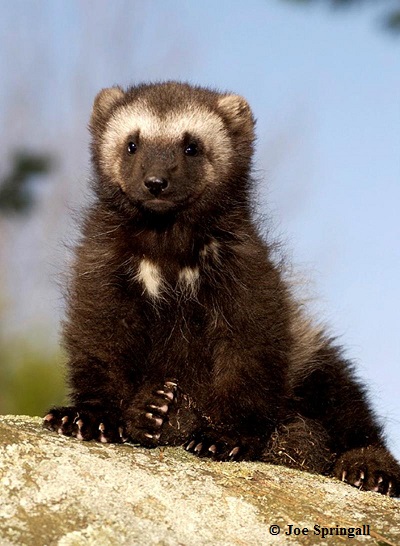
Wolverine kit
Wolverines mate in the summer and have a reproductive strategy known as “delayed implantation”, which is found in some mammals in seasonal climates. The egg is fertilized, but its development temporarily stops. The egg floats around in the uterus and implants some time later, as early as November or as late as March. This ensures that kits are born at an optimal time. The active period of gestation, or pregnancy, lasts 30 to 40 days. Birth occurs between February and May.
The female gives birth to and raises her kits in a complex den. It is common for females to move her kits from the den where they were born while she is raising them. Wolverines can have as many as six kits, but they typically have three or fewer. Not all of the young survive their first year: some die of starvation, others from predation. Wolverine kits grow quickly compared to the young of other mammals. This rapid rate of growth continues after the mother stops nursing her kits, which happens at nine or 10 weeks of age. Kits reach the size of adults by seven months of age.
When food is scarce, a high percentage of a population will not have young. In fact, some females may not reproduce even when food is apparently abundant, because raising young results in high energy costs. The mechanism of delayed implantation, which allows Wolverines to have young when food is most abundant and to adjust the size of the litter to the availability of food, is an effective way of reproducing without sacrificing precious energy.
Conservation
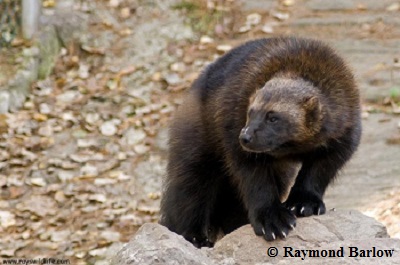
The Wolverine
Wolverines are subject to the same habitat threats that affect other large carnivores in Canada, like the grizzly bear. The Wolverine does not to thrive in habitats that have been permanently altered by land-based activities, such as agriculture, urban and industrial development, and human settlement. The problem is a combination of the actual loss of habitat, the presence of humans and the breaking up, or fragmentation, of the Wolverine habitat, as well as the increased human access to the habitat. Studies of Wolverine ecology do not suggest that Wolverines cannot co-exist with certain land-use activities, such as forestry, oil and gas extraction and mining. However, where such activities occur, especially if they are coupled with trapping, low-density Wolverine populations can have a difficult time surviving or growing. Even higher-density populations, such as those in the mountainous areas of British Columbia, can be negatively affected by human access and trapping.
Roads that permit human access to Wolverine habitat can be detrimental to Wolverine populations, especially if the animals are also killed by trapping or hunting. In areas where logging occurs, Wolverines may use the forested corridors adjacent to roads to get to other parts of their home ranges. This makes them vulnerable to trappers who use the same roads to set their traps, or more vulnerable to predation by other carnivores using these roads. Major roads, like the Trans-Canada Highway, can also keep Wolverines from reaching important parts of their habitat and Wolverines sometimes end up as roadkill.
The Wolverine pelt remains one of the most prized furs because of its beauty and because frost brushes off easily. The Inuit and Dene of northern Canada use Wolverine fur as trim and lining for their clothing, such as parkas, mitts, and moccasins. Over 80 percent of all Wolverine pelts sold in Canada—about 400 to 600 each year—come from the Northwest Territories, Nunavut, Yukon, and British Columbia. Wolverine fur is consistently high in value: a well-handled and prime pelt sells for an average of $400.

The Wolverine
Denning females are sensitive to disturbance, particularly human activity. Even the presence of careful researchers has caused Wolverines to abandon their dens. The increasing use of snowmobiles and skiing in the vicinity of Wolverine dens, such as in subalpine mountainous regions, can affect reproductive success of individuals and harm Wolverine populations. However, in tundra areas where recreational activity is much less concentrated, female Wolverines have tolerated human activity without abandoning their dens.
Since it often relies on other carnivores to hunt its food, efforts to control wolf populations in the past have been a threat to the Wolverine. Even if such efforts aren’t in effect today, their impact is still felt by Wolverine populations who haven’t recovered. Today, overhunting of caribou, one of the Wolverine’s main food sources, in some areas, is a threat to the species’ survival.
There are several elements in the species’ ecology that can hinder its recovery. The Wolverine’s low density and numbers make the recovery process very slow, since few young are born each year. Also, Wolverines have few natural predators, but they are occasionally attacked and killed, although seldom eaten, by wolves and other large carnivores. Eagles have been known to take young kits. Wolverine mothers go to great lengths to find secure dens for their young, suggesting that predation may be important in some areas. During the mating season, fights between resident males and other males can occur as they compete for females. It may be this fighting that encourages the young males to disperse considerable distances. Another element is that scavenging is a difficult way to survive. Many young, inexperienced Wolverines and very old Wolverines die from starvation, even if food is abundant. Transients, typically young adults passing through the territory, have a higher mortality rate than residents, because they do not benefit from hunting in a familiar home range.

The Wolverine
But several measures and actions are in place to conserve the Wolverine and help it recover. For example, a number of zoological organizations and individuals have been successful in raising Wolverines in captivity. Researchers have learned much about Wolverine behaviour from studying these captive animals. It has been suggested that Wolverines raised in captivity could be used in reintroductions, where Wolverines are moved to a new region in order to increase or augment existing populations or assist in the recovery of populations that are at risk. Also, research is done by many Canadian institutions in order to fill the knowledge gaps that we have about this mysterious animal. The information gathered by these scientists will help give the Wolverine a better chance.
The future of the Wolverine in Canada is of international importance. At present, Russia, Canada, and Alaska maintain the only large and relatively secure populations left in the world. Within North America, the species’ long-term survival in the western United States is dependent upon maintaining continuity with Wolverines in British Columbia and Alberta. Success at retaining wilderness in Canada may be the key to maintaining and restoring the Wolverine throughout its range.
Resources
Online resources
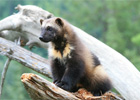
The Wolverine
Canadian Wildlife Service, Species at Risk
Print resources
Banci, V. 1994. Wolverine. In L.F. Ruggiero, K.B. Aubry, S.W. Buskirk, L.J. Lyon, and W.J. Zielinski, editors. The scientific basis for conserving forest carnivores: American marten, fisher, lynx and wolverine in the western United States. General Technical Report RM–254. U.S. Department of Agriculture, Forest Service, Rocky Mountain Forest and Range Experiment Station, Fort Collins, Colorado.
Egan, M. 2000. Endangered species in Canada. Hinterland Who’s Who series. Canadian Wildlife Service, Environment Canada.
Hash, H.S. 1987. Wolverine. In M. Novak, J.A. Baker, M.E. Obbard, and B. Malloch, editors. Wild furbearer management and conservation in North America. Ontario Ministry of Natural Resources, Toronto.
Krott, P. 1960. Ways of the wolverine. Natural History 69:16–29.
van Zyll de Jong, C.G. 1975. The distribution and abundance of the wolverine in Canada. Canadian Field-Naturalist 89:431–437.
Scientific Reviewers
Isabelle Thibault, biol., M.Sc., Ministère des Ressources naturelles et de la Faune, Gouvernement du Québec
Jason T. Fisher, BScH MSc PhD, Senior Research Scientist – Wildlife Ecology, Alberta Innovates – Technology Futures
Justina C. Ray, Ph.D., Executive Director/Senior Scientist, Wildlife Conservation Society Canada
© Her Majesty the Queen in Right of Canada, represented by the Minister of the Environment, 2013. All rights reserved.




